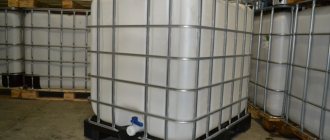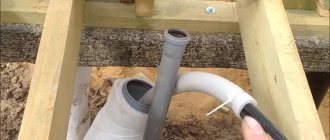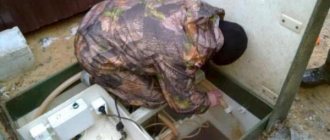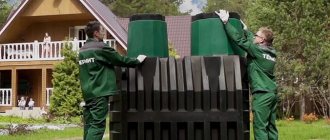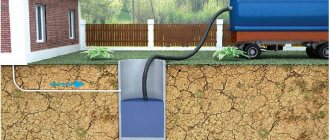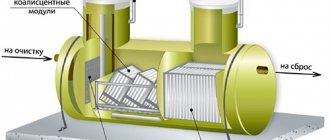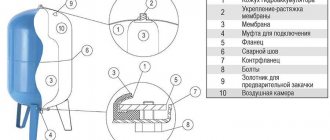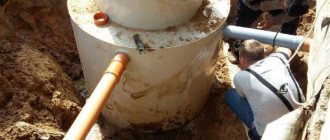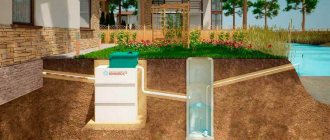Sequence of septic tank conservation
Preservation of the septic tank must be carried out before the onset of cold weather. This is justified by the fact that water can freeze in its devices. In addition, beneficial bacteria may die from hypothermia if preservation for the winter is carried out in extreme cold. Before starting work, it is necessary to warn everyone in the household that they cannot use the sewer. The water can be turned off to prevent it from entering the septic tank during dismantling.
After this, you need to perform the following activities:
- Turn off the power supply to the device. To avoid electric shock if you accidentally turn it on, it is advisable to disconnect the wires from the package switch.
- Pump out the contents of the tanks to such a level that all devices are on the surface. Clean them of accumulated debris. To do this you need to use a brush and clean water.
- Disconnect pumps, compressors, injectors and air lifts. Carefully fold them onto a clean cloth. The devices should be handled with extreme care to avoid damage. Before dismantling, you should take a photo or a graphic diagram so that nothing gets confused when assembling the septic tank in the spring.
- Fill the tanks with water to 75% of the maximum capacity.
- Insulate the system hatch. Provide protection for insulation from precipitation and morning dew. Only dry insulation will properly perform its tasks.
- Disassemble, clean and lubricate all removed equipment. Wrap it in a dry cloth and store it in a dry room. If the house will not be heated in winter, then it is better to remove the appliances and store them in a city apartment.
After such procedures, the bacteria enter a state of suspended animation. They will quickly come into working order when the weather warms up. You can speed up their activation by adding a small amount of homemade kefir to the container.
The septic tank is brought into working condition upon the onset of stable heat. After installing the instruments and equipment in place, the treatment station is connected to the network and filled with water. It takes 2 days for overwintered bacteria to acquire their normal properties.
- Turn off the power supply to the device. To avoid electric shock if you accidentally turn it on, it is advisable to disconnect the wires from the package switch.
- Pump out the contents of the tanks to such a level that all devices are on the surface. Clean them of accumulated debris. To do this you need to use a brush and clean water.
- Disconnect pumps, compressors, injectors and air lifts. Carefully fold them onto a clean cloth. The devices should be handled with extreme care to avoid damage. Before dismantling, you should take a photo or a graphic diagram so that nothing gets confused when assembling the septic tank in the spring.
- Fill the tanks with water to 75% of the maximum capacity.
- Insulate the system hatch. Provide protection for insulation from precipitation and morning dew. Only dry insulation will properly perform its tasks.
- Disassemble, clean and lubricate all removed equipment. Wrap it in a dry cloth and store it in a dry room. If the house will not be heated in winter, then it is better to remove the appliances and store them in a city apartment.
Eurolos Pro in winter
Preservation for seasonal use:
- Disconnect the equipment from the power supply;
- In models with forced discharge, disconnect the pipes, remove the pump and place it above the water level;
- Rinse the bioload of the submersible cassette;
- Clean airlifts;
- Perform one-by-one pumping of water from all chambers of the system using a sewage disposal machine or sewage pump, while simultaneously filling it with clean water;
- Fill all chambers of the Product with clean water to the overflow level.
Technology for spring re-preservation of a septic tank
At the beginning of spring, with the resumption of gardening work, the septic tank must be re-preserved, that is, all actions carried out during conservation must be carried out in the reverse order.
- remove the insulation;
- pull the sand bottles out of the chambers;
- place the pump and compressor in the appropriate chambers;
- connect the septic tank to the power supply.
The treatment station is ready, you can use it as before. She will return to normal operation in a couple of days. Basically, a septic tank does not need new bacteria, but to speed up the work process, you can add a liter of kefir or other fermented milk product to each chamber.
Healthy? Save it to your wall! Thank you for like!
To collect sewage waste at dachas and cottages, local treatment stations are increasingly being used, providing thorough filtration of wastewater with its subsequent processing. All organic impurities that enter this sealed structure are utilized by special aerobic bacteria.
Read more: Septic tank for the Topol dacha: review, reviews, advantages and disadvantages, model range
In the domestic market, treatment facilities of the TOPOL-ECO brand are popular among buyers. This brand is considered affordable, and the company’s specialists guarantee the highest quality wastewater treatment using their equipment. Buyers are offered several basic models designed to serve families of three or more people. The cost of construction is from 2,500 euros, depending on the model.
How to reactivate a septic tank
The process of “awakening” a septic tank is no more difficult than its preservation. In fact, it implies the same actions, only in reverse order:
- removal of insulation;
- dismantling the rope-bottle mechanism;
- returning to their original place the removed devices - pump and air compressor;
- inclusion of the station in the network.
Depreservation is usually carried out in early spring, simultaneously with the start of work on the garden plot. To “wake up” completely, bacteria need 2-3 days.
Advice. Sometimes, after reactivation, it is appropriate to add new bacteria to the system. If the septic tank begins to work more slowly, then ordinary fermented milk products will help correct this. Add a liter to each chamber.
Preserving a septic tank is a last resort if you are leaving your home for a long time. Even rare use of sewerage in winter will maintain the normal functioning of microorganisms. Taking into account the small losses of electricity, this is still more advisable than preserving the septic tank for the winter.
Insulation of a homemade septic tank
Naturally, instructions are not attached to a septic tank made independently using scrap materials.
Basically, home-made treatment plants are made with simple control systems, which means the conservation process will be simpler. To do this, the treatment station is disconnected from the power source, and equipment that may malfunction during the winter is removed. The amount of liquid is also checked and, if necessary, supplemented with water. If the septic tank is installed on a concrete slab and secured, then the water from the chambers can be drained. And finally, the treatment plant is insulated.
Basically, such actions to prepare the septic tank for the winter are enough for it to overwinter safely.
It should be noted that microorganisms need air to function well. Maximum insulation can be harmful, so several holes must be made in the polystyrene or polystyrene foam.
Polyfoam for insulating a septic tank
If the insulation is covered with plastic film, ventilation holes should also be made in it.
Many owners of country houses, and especially summer residents, in order to save money, are engaged in the independent manufacture of septic tanks from improvised materials. It is clear that such a structure does not have instructions for use. But every owner of such a septic tank will be interested to know how it is preserved for the winter.
If there is electrical equipment, it must be disconnected from the network.
Pumps, compressors and other devices that risk deteriorating during a long winter are removed from the septic tank.
The volume of liquid in the reservoir is added to ¾ of the total volume. According to the recommendations of some experts, it is enough to fill the container to 2/3 of the volume.
The septic tank lid is insulated using available materials - a layer of insulation, straw, dry leaves and others.
This preparation is quite suitable for a safe wintering of the septic tank.
When insulating a septic tank using polystyrene foam boards, do not try to isolate the septic tank from frost as completely as possible, because in order for aerobic bacteria to function normally, they need air. Therefore, it is advisable to leave special small holes in the insulation. If polyethylene is stretched over polystyrene foam, it should also have several corresponding holes.
The Topas-5 model is one of the most popular on the market. A true classic of this type of structure, designed for processing domestic and industrial wastewater. The treatment facility is designed to serve a family of five. Such models are most often installed in cottages, private houses and dachas.
The installation ensures complete sewage treatment. The water obtained as a result of purification can be used to water lawns and garden crops. The sludge collected in the settling tank is regularly pumped out and, after preliminary composting, is also used for household needs - it is an environmentally friendly fertilizer. Depending on the intensity of sewer use in a private home, the installation is cleaned once every three to four months.
Main technical characteristics:
- productivity up to one cubic meter of waste per day;
- work without adding reagents;
- year-round use possible;
- serving three to five people;
- simultaneous connection of one shower cabin, two sinks, toilet, washing machine is allowed;
- the installation can take up to 220 liters at a time (volley discharge when all plumbing fixtures in the house are working);
- the recommended depth for laying the sewer pipe is from 40 to 80 centimeters;
- sewage water from the house is drained by gravity;
- the weight of the installation is 230 kilograms;
- energy consumption for forced aeration is up to 1.5 kW per day.
Self-made cleaning stations usually have simple control systems, and therefore are easier to preserve. Adjust the exact algorithm based on the design of your specific septic tank. Minimum steps for conservation:
- As with industrial septic tanks, first disconnect the unit from the power source.
- Disconnect and remove any equipment that could be damaged by freezing temperatures.
- Check that the amount of water in the septic tank is at least 75%.
- If the unit is mounted on a concrete slab, drain the fluid from the chambers.
- Additionally, insulate the structure if the climate in your region is cold in winter.
Many owners of country houses, especially summer residents, in order to save money, made a septic tank themselves, using improvised means. Of course, no special instructions are attached to such a structure. How to preserve such a septic tank for the winter?
Typically, home-made treatment facilities do not have complex monitoring and control systems, so the conservation process here will be easier. To do this you need:
- Disconnect electrical equipment, if any, from the network.
- Remove pumps, compressors and other devices from the septic tank that may deteriorate during a long winter. (Of course, if there are no such devices in the septic tank, you can simply skip this point).
- Replenish the volume of liquid in the septic tank to a level of ¾ of the volume (some experts consider filling 2/3 of the volume quite sufficient).
- Insulate the top of the septic tank with available materials: a layer of insulation, straw, dry leaves, etc.
Usually such preparation is enough for the septic tank to safely overwinter.
If expanded polystyrene or polystyrene foam boards are used to insulate the septic tank, there is no need to strive for the most complete isolation of the septic tank from frost, since air access must be ensured for the normal functioning of aerobic bacteria. To do this, you can even make a number of special holes in the insulation. If the polystyrene foam is protected with polyethylene on top, you will also need to make corresponding holes in it.
The Topas-5 model is one of the most popular on the market. A true classic of this type of structure, designed for processing domestic and industrial wastewater. The treatment facility is designed to serve a family of five. Such models are most often installed in cottages, private houses and dachas.
Many country house owners assemble water treatment facilities from scrap materials. There are no instructions for homemade septic tanks, so you need to follow simple rules.
To prepare a homemade septic tank for wintering you will need:
- Disconnect electrical equipment, if any.
- Remove compressors, pumps and other equipment from the septic tank that may deteriorate during wintering.
- If there is not enough liquid, then it needs to be replenished to ¾ of the volume. Some experts claim that it will be enough to fill the structure to 2/3 of the volume.
- The septic tank lid should be insulated using heat-insulating materials.
This preparation will be enough for the septic tank to successfully survive the winter. Insulation can be done using expanded polystyrene or polystyrene boards. You don't need complete isolation. For the normal functioning of aerobic bacteria, it will be necessary to provide fresh air. To ensure ventilation, a number of small holes need to be made in the insulation.
Insulation of a septic tank
Advice. In order for bacteria to survive in winter, among other things, they need air. Therefore, when insulating, do not overdo it with insulation. In any material you need to make several holes for ventilation.
Read more: Methods and step-by-step instructions for attaching a toilet to the floor
Operating principle of the Topas septic tank
This unique domestically produced device purifies wastewater in several stages. The result of filtration is water that can be used without restrictions for technical purposes.
The first chamber of the system is designed for mechanical cleaning of the incoming liquid. Here, all solid impurities that settle on the filter meshes are removed from the water. After preliminary filtration, the water is supplied to the aerobic chamber.
In the aerobic chamber, microorganisms come into action and process wastewater into energy, water, methane and solid sediment. To collect sludge, sludge is used, which is loaded into a tank in a certain amount. Together with the sludge, the liquid moves into the settling tank.
In the settling tank, sediment falls to the bottom and the water is completely purified. As sludge is consumed, it is gradually replaced. The waste material is successfully used as fertilizer.
The installation operates autonomously, without requiring special control or human intervention. It is necessary to ensure that solvents and petroleum products do not enter the sewer system. These substances can completely destroy all beneficial microorganisms. In addition, you should not throw plastic bags, newspapers or toilet paper into the toilet. These items clog the filters and dry out the aerobic chamber.
Advantages of a septic tank and the need for conservation
Experts note the following advantages of the model:
- the installation is completely sealed;
- has relatively low energy consumption;
- works silently;
- cleaning efficiency reaches 99%;
- the structure is compact in size;
- During operation, there is no need to involve specialists - the system operates autonomously, and notifies owners of problems with an audible signal.
It should be noted that the treatment station has proven itself to be excellent when used in winter. Aerobic bacteria produce heat during active waste processing. And the internal chambers are heated by heat supplied from compressors pumping air. The operating temperature of these units is up to 70 degrees.
The manufacturer also took care of additional insulation. Polypropylene, used for the manufacture of septic tanks of this brand, has low thermal conductivity. At winter temperatures below twenty degrees, the cover of the device should be additionally insulated, while ensuring free flow of air through the ventilation pipe.
Preservation of a septic tank is required only if it is used seasonally. When the owners leave the dacha during the cold season, the device must be taken out of service!
Why do you need to conserve your septic tank?
Some owners fear for the integrity of the septic tank tank in winter. As an argument, they give the example of a heating system that, when defrosted, “breaks” the pipes and fails. However, a septic tank behaves differently in cold weather. If installed correctly, it is protected from such damage. The following installation is considered correct:
- Depth - about 2 m. In cold regions even lower, depending on the depth of soil freezing.
- The supply pipes are located at an angle, thanks to which the wastewater does not stagnate in them and manages to maintain the temperature on the way from the home to the container.
- If necessary, pipes and containers can be insulated with foam plastic or expanded clay.
Attention! These criteria are considered relevant for any material from which a treatment plant is usually made - metal, concrete, plastic.
With regular use of the sewer, the activity of bacteria in the container maintains the temperature above zero. But if you need to leave your home during the cold season for a period of 1 month or longer, then the septic tank should be mothballed. Factory installations of autonomous sewage systems require a standard procedure. It differs slightly depending on the manufacturer.
The septic tank should only be preserved if you are going to be away from the house for a long time.
Preservation procedure
To properly shut down the treatment plant, you must follow the instructions supplied with the product by the manufacturer. Typically, conservation includes several important steps:
- The contents are pumped out and the station is filled with clean water to approximately 80% of its capacity. This is done in order to prevent accidental floating of the septic tank. Visually, the liquid inside the chambers of the device should become clearer.
- Then all nozzles and airlifts are washed, and the pumps are cleaned. After which the station is disconnected from the power supply.
- Pumps and compressors are dismantled. They are stored in a warm utility room in winter.
- In the spring, the septic tank is assembled and put into operation following the reverse sequence of all stages. Assembly begins with the installation of compressors and pumping equipment, as well as filling the chambers with clean water to the operating level.
You can carry out conservation work yourself or enter into an agreement with the manufacturer for additional maintenance of the device.
In this case, annual conservation and re-preservation will be carried out by company specialists.
Other septic tanks supplied to markets, as well as compact models from the Unilos brand (Astra model range), are preserved using a similar scheme.
Conservation can be considered using the example of the Unilos Astra 5 or Unilos Astra station:
- the treatment plant is de-energized (use a special button on the body);
- the lid is opened and a visual inspection of the chambers is made - if there is large mechanical debris floating on the surface of the water, it must be removed;
- coarse filters are removed and washed;
- when the liquid level is low (about three-quarters of the chambers), it is recommended to add clean water;
- the pump removes sludge;
- the pumps and compressor are removed - this equipment is stored indoors;
- plastic two-liter containers filled to the top with dry sand are immersed in the chambers, which prevent the destruction of the treatment plant under the influence of low temperatures with possible freezing of water;
- The lid is returned to its place and further insulated.
If the shower in your home is working very poorly, then perhaps purchasing a water pressure booster pump will help solve this problem.
In order for storm drainage to work for a long time and correctly, it is necessary to carry out high-quality maintenance. Read more about this in our article.
What you need to know about using a septic tank in winter
Autonomous sewerage must be placed underground at a certain depth, below the soil freezing level. Thanks to this, even during the cold period, the temperature in the heat exchanger will not drop below +5 degrees. This will prevent the death of aerobic bacteria and damage to treatment equipment. Modern models of septic tanks are made of polymer materials. The finished product is characterized by lightness, strength and reliability. Light weight greatly simplifies the process of delivering the cleaning unit. It will be much easier to install on site. However, this can also become a problem. When groundwater rises, the autonomous sewage system may float to the surface and rise slightly. Therefore, it is not recommended to completely drain the liquid from the reservoir. A properly installed septic tank and compliance with the above recommendations will prevent freezing of the autonomous sewage system even in winter. Due to the fact that there will always be water in the filtering equipment, any movement is excluded. The liquid present will allow you to maintain the required weight, which will help securely fix the structure even when groundwater rises.
Important points of conservation
The appeal of owners of local industrial-style septic tanks to specialists is associated, first of all, with errors made during conservation. Theoretically, there is nothing complicated in this procedure, but in practice, beginners often make the following mistakes:
- Completely drain the device. Doing this is strictly prohibited! An empty station is light in weight and floats up when the groundwater level rises in the spring, that is, even before the septic tank is put into seasonal operation. As a result, the owners' entire sewer system completely fails.
- Improper insulation is another common mistake. Soil or sand is poured onto the hatch, which penetrates into the station when snow melts and rains. In the spring, this complicates the start-up of the system - you have to re-rinse the filters and chambers of the structure.
- Failure to use containers with sand can cause destruction of the septic tank body. In case of possible freezing of the water remaining in the chambers, plastic bottles help prevent critical deformation of the body.
Like any equipment, local treatment facilities or LOCs require regular maintenance, which will help carry out winter conservation of the equipment without any problems.
Owners must be sure that the system mechanisms are not damaged. The integrity of the filters, hoses and other parts of the septic tank will avoid lengthy flushing of the device during the conservation process and will ensure its uninterrupted operation when starting up in the spring. Visual inspections are carried out regularly (about twice a month).
The sludge is removed quarterly by a built-in pump by pumping it into a previously prepared container. If this procedure was missed during maintenance for six months, pumping is done using a drain pump.
Experts strongly recommend not to neglect the quality maintenance of the purchased treatment plant! If you can’t regularly carry it out on your own, you can contact a specialized company and sign a service agreement.
An improperly functioning biological septic tank is difficult to preserve and even more difficult to put into operation in the spring. And with careful maintenance and proper conservation, septic tanks last for several decades.
Preservation in accordance with maintenance rules means:
- incomplete pumping of water;
- using sand bottles;
- thorough insulation.
At the same time, all parts and filters must be in working condition for quick reactivation of the system in the spring and its start-up.
